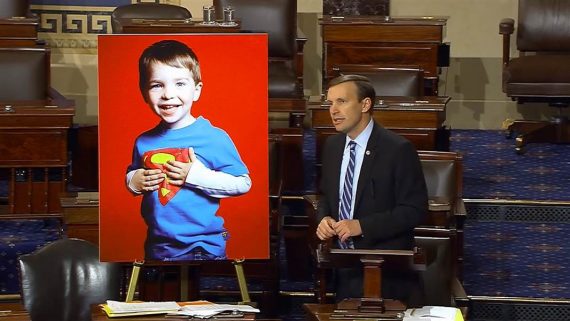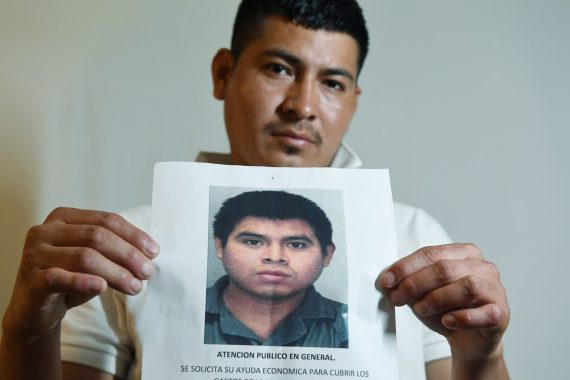
Sen. Chris Murphy filibusters after Sandy Hook shootings in his state, demands mental health reforms and end to gun violence.
(12-26-16) I’ve written more than a dozen blogs in the past four years about efforts to get major mental health care legislation signed into law. That happened earlier this month when President Barack Obama signed the 21st Century Cures Act, which including major mental health bills.
Senator Chris Murphy (D-Conn.) has written a fascinating behind the scenes account of what happened from his viewpoint after he and Sen. Bill Cassidy (R-La.) joined Rep. Tim Murphy (R.-Pa.) in pushing for reforms after the horrific Sandy Hook Elementary school shootings in 2012 when 20-year-old Adam Lanza fatally wounded 20 children between six and seven years old, as well as six adult staff members. Here is part one of the journey pulled from a open letter that he sent via email to his constituents.
Getting Mental Heath Reforms Signed Into Law: Sen. Chris Murphy’s First Hand Account
In January of 2015, I was holding supermarket office hours in Stamford, Connecticut, and an older woman came running up to us in a panic. Her mentally ill (and developmentally disabled) grandson was having a violent breakdown in the backseat of her car, and she feared for his safety. The blood had drained from her face – you could tell she had been through this dozens of times before – and I rushed to the car with a police officer to try to settle the boy.
The mother was in the backseat with him, desperately trying to calm him, looking just as panicked as the grandmother. As we gained control over the situation, the grandmother, exhausted, told me how this little boy’s illness has come to dominate every aspect of their extended family. They tried, over and over in vain, to find appropriate services for him, to no avail. Left alone, they were helpless, and scared. And most of all, furious – furious that there was nowhere to turn to get help for this child.
He was eight years old.
That incident literally moved me to tears.
I’ve been involved in mental health policy my entire legislative career. But that day, I decided I wasn’t just going to “work” on the issue any longer. I was going to lead. I committed myself to convincing my colleagues in the Senate that the status quo in our behavioral health system was unacceptable. It was time for big, comprehensive reform.
This week, I stood behind the President as he signed into law the Mental Health Reform Act, the most comprehensive reform of our nation’s mental health laws in a generation. I spent two years writing the bill, building bipartisan support for it, and creating a national movement to get it passed.
This is the behind-the-scenes, inside story of how it happened. As with my prior behind-the-scenes accounts (they keep coming because I get so much good feedback on them!) this one is long. A good 20 minute read. But I hope it will be worth your time.
“Crazy”
I have two initial tasks in the winter of 2015. The first is to start talking to tons of smart people in Connecticut about what was wrong with our behavioral health system and how we can change it. I ask two of the smartest people in the field – Hank Schwartz of Hartford’s Institute of Living, and Steve Larcen, the President of Natchaug Hospital – to come down to Washington and spend a full afternoon with me setting the table for the coming conversation. We conceive a series of roundtables and forums in every corner of Connecticut where patients, parents, doctors and social workers could tell their stories.
My other task is to find a Republican Senator who will co-lead the effort and the bill with me. On a shuttle bus at the Baltimore airport that winter, I run into Andrew Sperling of the National Alliance on Mental Illness (NAMI), and I tell him about my desire to write a big, sweeping mental health reform bill. He tells me about a new Senator from Louisiana, Bill Cassidy, who he had watched during Cassidy’s time in the House of Representatives. Andrew recalls Cassidy coming to committee hearings on mental health with a worn, dog-eared copy of the book “Crazy” by former Washington Post writer Pete Earley. The book is Earley’s tragic story of his son’s descent into serious mental illness and, eventually, the criminal justice system. Earley makes the case for dramatic reform of the way we treat the mentally ill, and Sperling notes that if Cassidy cares so much about that book, maybe he would be a good partner.
So a few weeks later, I approach the new Senator on the Senate floor, and pitch him on the idea of working together. His eyes light up immediately, and he agrees on the spot to beginning the process.
The “other” Murphy
The biggest decision we make early in 2015 is to not reinvent the wheel. Congressman Tim Murphy of Pennsylvania, a psychologist, had two years earlier introduced the Helping Families in Mental Health Crisis Act, a major set of reforms to mental health law largely directed at helping treat individuals who already had been diagnosed with serious mental illnesses like schizophrenia or bipolar disorder. There are a lot of controversial ideas in Murphy’s bill, including a requirement that states adopt laws to force seriously mentally ill people into outpatient treatment through court orders. But Tim has already gotten over a hundred Republicans and Democrats in the House to cosponsor his bill, so using it as a template, and selling our bill as the Senate companion to his, was to our benefit.
The good news is that I already was friendly with Rep. Murphy. When we served together in the House, our gym lockers were next to each other, and every morning we would chat as we got ready for the day. Murphy can be intense about the need to reform the mental health system, but he is happy to finally have Senators to work with, and Cassidy and I begin the process of working out a new version of Murphy’s bill to introduce in the Senate.
The Big Reveal
In August of 2015, after holding dozens of roundtables and getting input from every stakeholder we could, we introduce our bill, entitled the Mental Health Reform Act of 2015. It is sweeping, and goes after all of the issues we had heard about from frustrated patients, caregivers, and family members. It expands access by increasing funding for outpatient care and inpatient care by billions of dollars. It requires insurance companies to stop discriminating against patients trying to access mental health care. It incentivizes states to bring together their physical health systems and their mental health systems. It clarifies privacy laws so that parents, like Pete Earley, could be more participatory in their adult children’s care.
And the bill is bipartisan. One of the most important decisions we make is to only add co-sponsors to the bill in pairs – one Democratic Senator and one Republican Senator. We introduce the bill with me and Cassidy, along with Democrats Al Franken and Debbie Stabenow, and Republicans David Vitter and Susan Collins as the first cosponsors.
At the press conference all the major mental health groups, who have been part of the drafting process, are in attendance. At the event we acknowledge the elephant in the room – the tragedy at Sandy Hook. Several of the families have been instrumental in drafting the bill. One section, which establishes funding for early intervention programs for children who display risk factors related to mental illness, is critical to the group of parents who had formed the Sandy Hook Promise organization. But I’m careful not to mix the issues of mental illness and gun violence. Why? Because the reality is that there is no inherent connection between mental illness and violence. And the story of the United States’ epidemic rates of gun homicide can’t be explained away by mental illness – other nations have similar rates of mental illness as the U.S. but only here do mentally ill people grab guns and start shooting. It’s a fine line – acknowledging though not overselling the connection – one that we struggle to walk for the next year and a half.
Building a Grassroots Powerhouse
Now we begin the work of building up support for the bill to get it passed into law. I have never gotten a bill of this size, on this controversial a topic, passed before. Neither has Cassidy. In fact, many members of Congress or Senators go their entire careers without getting something this substantial made into law. So these are uncharted waters for both of us.
Cassidy and I continue doing events in our home states. I keep up the forums and roundtables, getting more and more good insight into how to improve the bill, eventually holding more than 30 overall. Bill is especially focused on creating connections with law enforcement in Louisiana, an important ally in the fight given the fact that jails and prisons have become our new de facto mental health institutions.
In Washington, we hold meetings with the mental health advocacy groups, and urge them to get their members around the country to talk to their Senators about the bill and encourage them to sign on as cosponsors. We do joint media appearances, hold a mental health summit in Washington that is attended by hundreds, and vigorously lobby our colleagues, especially the Chairman and Democratic ranking member on the Health Committee, Lamar Alexander of Tennessee and Patty Murray of Washington.
First Signs of Trouble
We have always expected that Tim Murphy’s bill in the House would move faster than ours since he had a two year head start. But as 2015 wears on, little progress is being made in the House. Tim, Bill, and I chat every now and again, and I keep reaching out to my Democratic friends in the House to push them toward compromise. But Tim Murphy is insisting on provisions in his bill and House Democrats have different ideas, so no common ground on the controversial parts of the House bill is being found. Tim has a special connection to this bill that he has conceived and nurtured – it’s hard for him to accept compromise. His passion is both his strength and his weakness. Murphy forces the bill through a subcommittee in the House, but it’s a bitter, lengthy debate and in the end, only one Democrat supports the bill.
And in the Senate, we’re running into some trouble too. Chairman Alexander agrees to help redraft our bill into a form he and the Republicans on the committee can accept and then bring it for a “mark-up” in the committee (a committee meeting to amend and approve a bill). But our bill has a large section in it requiring insurance companies to approve mental illness treatments in a manner equal to the way they approve physical health treatments. What we have learned is that though insurance plans claim to cover mental illness, often they really don’t because when you try to get insurance approval for a residential program or an outpatient treatment regimen, the insurer just denies it as not medically necessary. Our bill would fix that, but it has the insurance companies (and thus some of their Republican allies on the Health Committee) up in arms.
To compound our troubles, a competing mental health reform bill is introduced in the Senate by Texas Republican John Cornyn. His bill threatens to upset the delicate balance Cassidy and I are trying to strike between mental health reform and gun policy. Cornyn’s bill – large portions of which had originally been drafted and championed by Democratic Senator Al Franken – makes some really helpful changes to the way the criminal justice system treats mentally ill individuals, but it also makes changes to the gun background checks system to allow more people with serious illness to buy weapons. Cornyn’s bill is 90% positive – he’s a true, committed advocate for keeping the mentally ill out of prison and getting them in treatment – but the gun sections of his bill threaten to pull down the whole debate. And he’s sending signals, as we head into 2016, that if his background checks language doesn’t get in the final bill, he and the Republican leadership aren’t going to support it.
(Tomorrow: Breakthroughs that lead to passage!)






